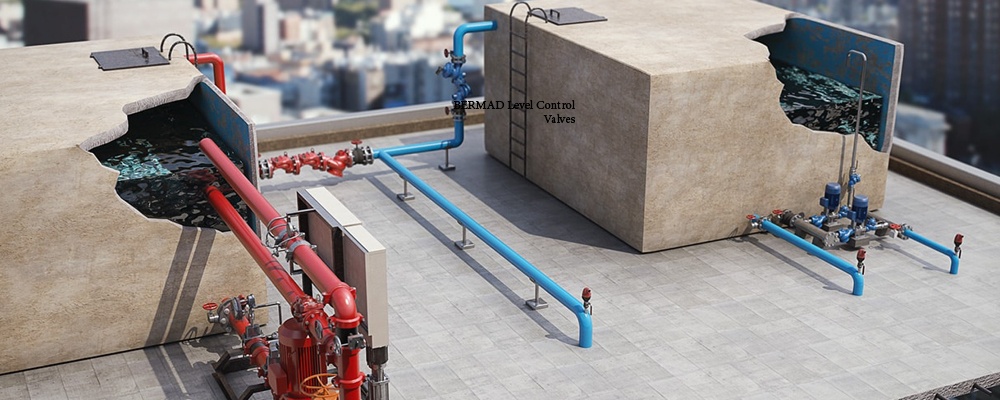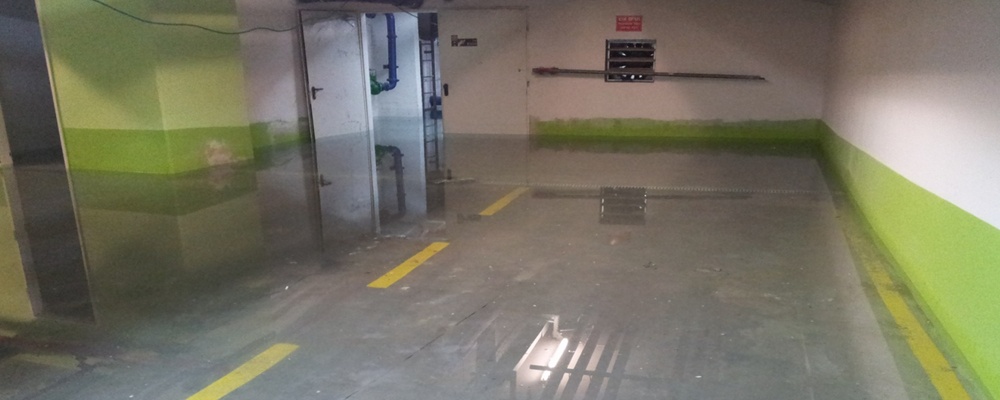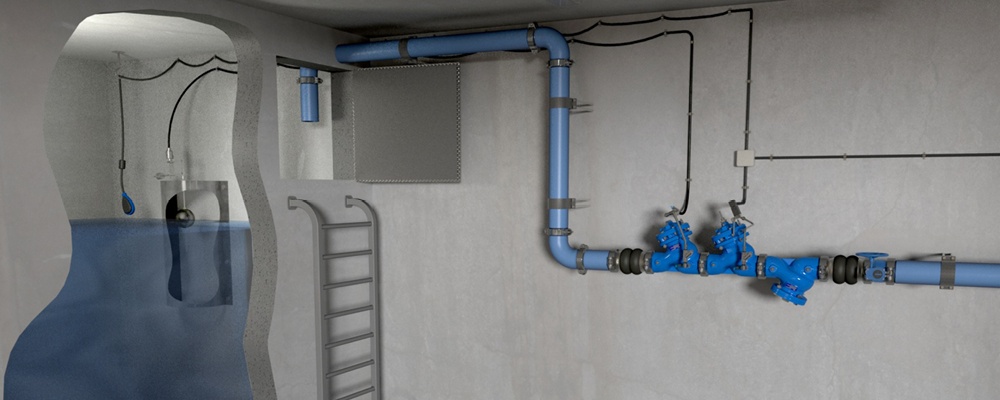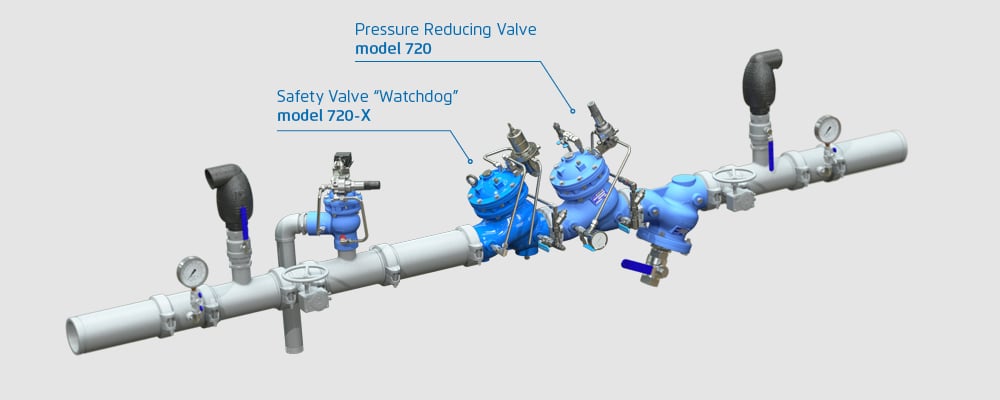Designing a safe, effective water delivery system for a high-rise building presents a number of challenges. One of these is ensuring that the water in basement and rooftop reservoirs remains at an acceptable level at all times. If the level is too low or too high, it may result in poor service to consumers; and overflow can result in catastrophic damage to property. The installation of a level control valve in the system can help keep water at a safe level and prevent these issues.
Design concerns and challenges of reservoirs in high-rise buildings
To fully understand control valve recommendations for water system level control in tall buildings, it’s helpful to review reservoir location design. Reservoirs are most commonly located in the basement of the building or on the roof. The purpose of the basement reservoir is to create a buffer from the city main and to supply independent water requirements.

Typical installation of basement reservoir divided into two separate chambers with a pumping system on the left and level control valves on the right
In a very tall building, it is important to supply water at all times at adequate pressure to all floors. For this reason, many buildings feature a rooftop reservoir, which keeps “water at the ready” to facilitate sufficient pressure supply even in conditions with irregular municipality water supply and in electric power failures.

Typical installation of roof-top reservoirs with the drinking water reservoir on the right (blue pipelines) and the fire protection reservoir on the left (red pipelines)
In addition, there may be multiple water supply systems in a single building – for instance, for drinking water and fire protection. In such cases, each system may be equipped with its own reservoirs. There are several reasons to use separate reservoirs for fire water versus drinking water. Some of these include fire water supply assurance, differing water treatment needs, pumping limitations, and energy conservation.
Proper reservoir level control is important to prevent a number of unwelcome issues for building managers and occupants. These include overflow, supply failure, bacterial growth in the reservoir, and noise during the filling process.
Preventing reservoir overflow with level control valves
An overflowing rooftop reservoir can cause catastrophic damage to property. It can also create dangerous conditions by flooding into elevator piers and electricity rooms on the roof.
In the basement, reservoirs can overflow into storage and/or parking facilities, pumping rooms, and machine rooms, where it can severely damage equipment and property.

Overflow from basement reservoir
Reservoir overflow can be caused by any one or a combination of the following:
- Failure to seal against pipe pressure
- Faulty float (electric or hydraulic)
- Improper float installation
- Back flow from pump system raisers
BERMAD level control valves are designed to prevent these issues by automatically keeping the reservoir water at proper levels regardless of fluctuating demand. In addition to using line pressure to seal, these valves are hydraulically operated to ensure proper functioning even in the event of a power failure.

BERMAD solution for preventing reservoir overflow
BERMAD recommends installing a backup bi-level electric level control valve in addition to the main hydraulic level control valve to ensure uninterrupted overflow protection should the main valve experience operation conditions that interfere with its proper function. In such cases, the electric level control valve will kick into action and stop overflow.
It is common to add a limit switch to the BERMAD level control valve, which communicates the level of the valve to the Building Management System (BMS). It is important to include this on emergency valves as well as main valves to alert maintenance personnel that the main valve has malfunctioned and the emergency wheel is in use.
Using bi-level control valves for bacterial overgrowth prevention in drinking water supply systems
In potable water supply systems, it is important to ensure adequate turnover of water in the tank. Failure to do so will create stagnant conditions, increasing risk of bacterial overgrowth in the reservoir.
For this reason, BERMAD recommends using hydraulic or solenoid controlled bi-level valves (such as the BERMAD 750-65-P) rather than a modulating float in drinking water systems. This will ensure that a large volume of water is replaced in the water tank, resulting in a higher level of sanitation in the potable water system.
However, the maintenance of control floats installed in the reservoirs may be risky for maintenance technicians. Therefore, where possible, it is best to station the main control unit outside of the water reservoir for easy maintenance using balancing tanks.
In addition to large volume water replacement, BERMAD bi-level control valves offer the following benefits:
- Seals with the supply pressure and not against it
- Double chamber option for low pressure installation
- Auxiliary pressure control option
- Integration with building management system
- The valve operates fully open for filling the reservoir
- Longer life cycle (less operations of the valve)
- Lower noise generation
- No cavitation conditions
- Full function operation at low pressure
Modulating level control
Modulating level control will top-up the exact volume of water in correspondence with consumption and maintain a maximum water level in the reservoir at all times. It is recommended to use modulating level control valves in the following situations:
- In fire protection reservoirs
- When the water supply is not reliable and it is important to keep reserved water at maximal capacity
- When the reservoir is shallow and wide
- When the reservoir is small
Avoiding pressure drop in water systems for high rise buildings
When the flow used to fill the reservoir is high, the system adjacent to the reservoir supply pipeline might experience a drop in pressure. This could interfere with proper water delivery to consumers and may cause problems in the water system.
In cases where the filling-line in the reservoir is used for systems supplying potable water to consumers, BERMAD recommends the addition of a pressure-sustaining feature to the emergency valve.

Visit the BERMAD website for a complete list of available level control valves.
Got specific questions about level control valve installation or selection?
It is important to choose the right control valves for your unique requirements. Proper level control valve unit selection depends on a number of factors. To learn more about reservoir level control solutions for tall buildings, or for technical assistance with reservoir design, contact us here to reach a BERMAD representative in your region.












